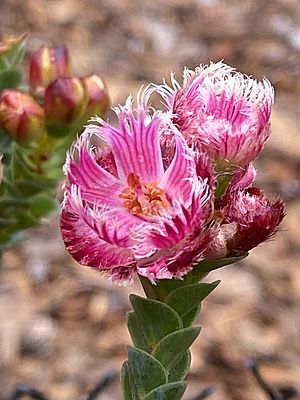Oval-leaved featherflower facts for kids
Quick facts for kids Oval-leaved featherflower |
|
|---|---|
 |
|
| In the Australian National Botanic Gardens | |
| Scientific classification | |
| Genus: |
Verticordia
|
| Species: |
ovalifolia
|
Verticordia ovalifolia, commonly known as the oval-leaved featherflower, is a beautiful flowering plant. It belongs to the Myrtaceae family, which is the same family as myrtle plants. This special plant grows only in the south-west part of Western Australia. It's a shrub with open branches, and its leaves look like small eggs. In spring, it shows off its unique, feathery, strap-like petals.
Contents
What it Looks Like
The oval-leaved featherflower is a shrub that usually grows up to 80 centimeters (about 31 inches) tall and 90 centimeters (about 35 inches) wide. It has several main stems and a few smaller branches. Its leaves are shaped like an ellipse or an egg, and they are about 4 to 7 millimeters long. They also have edges that are a bit see-through.
The flowers have a light scent and grow in round groups near the ends of the branches. Each flower sits on a small stalk that is about 6 to 8 millimeters long. The base of the flower, called the floral cup, is shaped like a top and is about 3 millimeters long. It is smooth and has small extra parts around its edge.
The sepals (leaf-like parts that protect the flower bud) are green and 5 to 8 millimeters long. They have ten to thirteen feathery parts that are cream to pink in color. They also have two small, ear-like, hairy parts. The petals (the colorful parts of the flower) are cream, reddish, or purplish. They stand upright and are 8 to 9 millimeters long. They are shaped like a rectangle or a wedge and look like straps with a deeply divided outer edge. The style (the part of the flower that receives pollen) is 7 to 8 millimeters long, straight, and very hairy near its tip. This plant usually flowers from August to December.
Plant Names and History
Every plant has a scientific name, and Verticordia ovalifolia was first officially described by a scientist named Carl Meisner in 1857. He wrote about it after James Drummond collected a sample of the plant. This description was published in a science journal.
The second part of its scientific name, ovalifolia, comes from two Latin words: ovalis (meaning oval) and folium (meaning a leaf). This name describes the oval shape of the plant's leaves.
Later, in 1991, another scientist named Alex George studied the whole Verticordia group of plants. He placed Verticordia ovalifolia in a special subgroup called Eperephes. It's the only plant in its specific section, Corynatoca.
Where it Grows
This verticordia plant usually grows in sandy soil, sometimes with gravel that has a lot of iron in it. It often grows alongside other Verticordia species in areas with heath (low-growing shrubs) and shrubland.
You can find it in two separate areas in Western Australia. One area is between the cities of Perth and Geraldton. The other area is between Dumbleyung and Lake King. These areas are part of different natural regions like the Avon Wheatbelt and the Swan Coastal Plain.
How it's Protected
The Western Australian Government's Department of Parks and Wildlife has looked at the oval-leaved featherflower. They have officially classified it as "not threatened," which means it is not currently in danger of disappearing.
Growing it in Gardens
The oval-leaved featherflower is known as a "beautiful, attractively foliaged shrub." People have grown it in gardens and in pots. It does best in soils that drain water well.
It's usually grown from cuttings, which means taking a piece of the plant and helping it grow roots. You can also grow it from seeds. Sometimes, people use a method called grafting. This is where you join a piece of the oval-leaved featherflower onto the roots of another plant, like Chamelaucium uncinatum. This can help the plant grow into a bushier shrub with many flowers.

